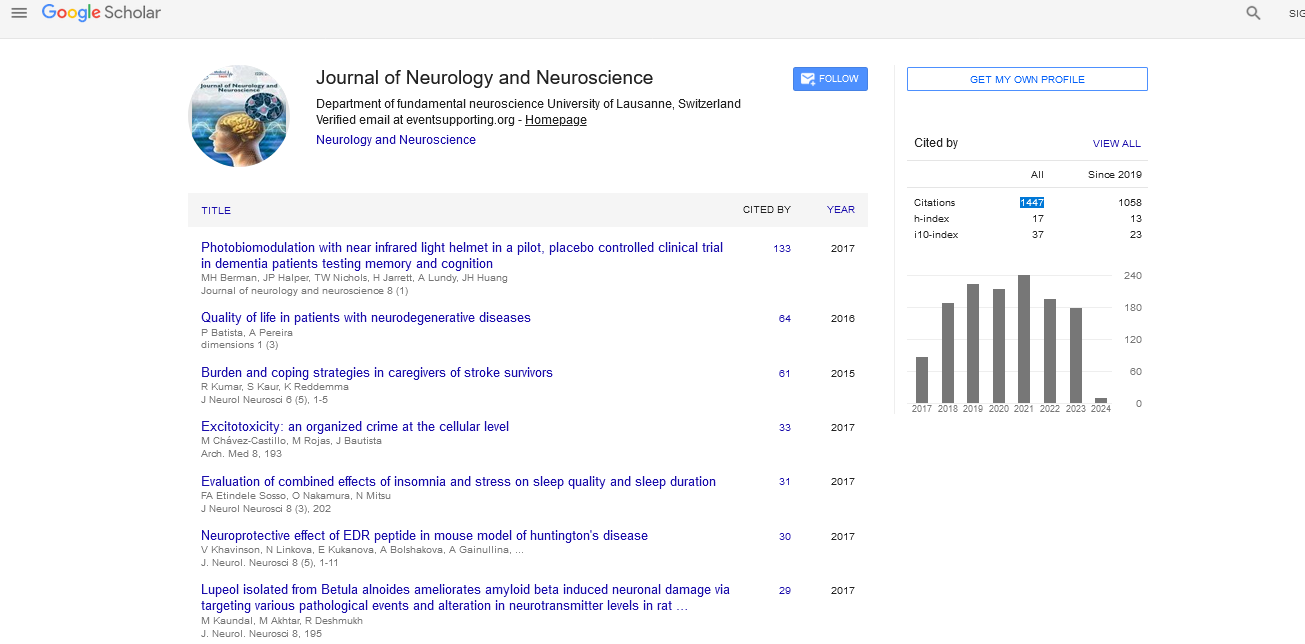Commentry - (2025) Volume 16, Issue 1
Exploring alternative computational learning methods in behavioral neuropharmacology: Findings from an experimental anxiety model
Bengoetxea Mello*
Department of Neuroetología, Universidad Veracruzana, Xalapa 91090, Mexico
*Correspondence:
Bengoetxea Mello, Department of Neuroetología, Universidad Veracruzana, Xalapa 91090,
Mexico,
Email:
Received: 30-Jan-2025, Manuscript No. ipjnn-25-15565;
Editor assigned: 01-Feb-2025, Pre QC No. P-15565;
Reviewed: 14-Feb-2025, QC No. Q-15565;
Revised: 20-Feb-2025, Manuscript No. R-15565;
Published:
27-Feb-2025
Introduction
The intersection of computational learning and
behavioral neuropharmacology has emerged as an
important area of research, especially in the context of
understanding complex psychological conditions like
anxiety. Anxiety disorders are prevalent worldwide,
affecting millions of people and imposing a significant
burden on public health systems. Despite the availability
of pharmacological treatments, a substantial number of
patients do not respond well to conventional therapies,
leading researchers to explore alternative methods that
could provide new insights into the mechanisms of anxiety
and potential treatments. In this paper, we will delve
into the integration of computational learning methods
within the domain of behavioral neuropharmacology,
focusing specifically on their application in experimental
anxiety models. By examining alternative approaches,
we aim to highlight how computational methods can
enhance our understanding of neurobiological processes
involved in anxiety, offer new avenues for treatment, and
ultimately improve clinical outcomes for those suffering
from anxiety disorders [1].
Behavioral neuropharmacology is the study of how
drugs influence behavior through their effects on the
nervous system. In the case of anxiety, this involves
understanding how various pharmacological agents
interact with neurobiological systems to produce either
anxiolytic (anxiety-reducing) or anxiogenic (anxietyinducing)
effects. Traditional experimental anxiety models
often rely on rodent subjects, where behavioral changes
such as increased locomotion, freezing, or grooming are
used as indicators of anxiety levels. These models can be
divided into several categories, including the elevated
plus maze, the open field test, and the forced swim test.
However, as research has progressed, it has become
clear that these traditional approaches do not always
provide a complete understanding of the underlying
neural mechanisms. Furthermore, individual variability,
both in animal models and human subjects, complicates
the process of interpreting behavioral outcomes. As
such, there is an increasing need for more sophisticated,
computational methods that can handle the complexity
and variability inherent in behavioral data [2].
Description
Computational learning methods refer to the use of
algorithms and models to analyze and predict patterns
in data, often drawing from the fields of machine
learning, statistical modeling, and neural networks. In
the context of behavioral neuropharmacology, these
methods can be used to analyze large datasets from
experimental studies, model complex interactions
between pharmacological agents and neural circuits,
and predict the effects of new treatments. One of the
primary benefits of computational methods is their ability to handle complex, multidimensional data. For example,
in anxiety research, behavioral outcomes are not just a
simple yes/no answer (i.e., anxious or not anxious); they
involve a spectrum of behaviors that can vary in intensity
and duration. Computational models can analyze these
behaviors in a more nuanced way, helping to identify
subtle patterns that might be missed by traditional
methods. Additionally, computational approaches
allow researchers to model and simulate the effects of
pharmacological agents on neural circuits, potentially
revealing underlying mechanisms that are not easily
observed through direct experimentation. These models
can help identify key neural pathways involved in anxiety,
and predict how specific drugs may modulate these
pathways. This is particularly useful in exploring new or
untested pharmacological compounds, as it can inform
preclinical testing and reduces the reliance on trial-anderror
approaches [3].
To illustrate the application of computational learning
in behavioral neuropharmacology, it is helpful to examine
how these methods can be applied within the context of
an experimental anxiety model. A commonly used animal
model in anxiety research is the elevated plus maze. In
this test, rodents are placed on a platform with two open
arms and two closed arms, with the primary measure
being the amount of time the animal spends in the open
versus the closed arms. Increased time spent in the open
arms is typically considered an indicator of lower anxiety,
while greater time spent in the closed arms suggests
higher anxiety. However, interpreting the results of this
test requires accounting for a variety of factors, including
the animal’s baseline level of anxiety, its previous
experiences, and the influence of pharmacological
agents. Traditional methods of analysis might focus on
simple measures, such as the time spent in each arm,
but these metrics do not capture the full complexity of
the animal’s behavior. Computational learning methods,
such as cluster analysis or hidden Markov models, can
be used to classify and predict patterns in behavior over
time, accounting for the natural variability in response to
different anxiety-inducing stimuli.
Another promising computational approach is
reinforcement learning, which can be used to model how
animals learn and adapt to their environment in response
to anxiety-provoking stimuli. In a reinforcement learning
framework, the animal’s behavior is treated as the
outcome of a series of decisions based on the environment
and internal state. This method can be used to study
how animals learn to avoid anxiety-inducing situations
or how they adjust their behavior when faced with new
or unpredictable threats. It can also be applied to study
how different pharmacological treatments modulate the
animal’s decision-making process and whether they alter
the way animals interact with their environment [4].
In addition to behavioral models, neuroimaging
techniques such as functional magnetic resonance imaging
(fMRI) and electrophysiology can provide insights into
the neural mechanisms underlying anxiety. By integrating
computational learning techniques with neuroimaging
data, researchers can gain a more comprehensive
understanding of the brain areas involved in anxiety
and how they interact in response to pharmacological
treatments. For instance, a computational model could
combine behavioral data from the elevated plus maze
with fMRI scans to identify which brain regions are most
active during periods of high anxiety. By analyzing these
data together, the model could reveal how specific
pharmacological agents alter neural activity in these
regions and predict the behavioral outcomes that are
likely to result. Such models could also help identify
biomarkers of anxiety that could be used to monitor
treatment efficacy or predict individual responses to
therapy [5].
Conclusion
Exploring alternative computational learning
methods in behavioral neuropharmacology offers
exciting new possibilities for understanding and treating
anxiety disorders. By combining sophisticated algorithms
with experimental models, researchers can gain a more
nuanced understanding of the complex relationship
between pharmacology, behavior, and brain function.
These methods hold great promise for identifying novel
therapeutic targets, improving treatment outcomes, and
ultimately advancing our knowledge of how anxiety
develops and can be effectively managed. As this field
continues to evolve, it will likely play a central role in the
future of anxiety research and treatment.
Acknowledgment
None.
Conflict of Interest
None.
References
- Mayer B, Kringel D, Lötsch J. Artificial intelligence and machine learning in clinical pharmacological research. Expert Rev Clin Pharmacol. 2024; 17(1):79-91.
Google Scholar, Crossref, Indexed at
- García-Ríos RI, Mora-Pérez A, González-Torres D, et al. Anxiolytic-like effect of the aqueous extract of Justicia spicigera leaves on female rats: A comparison to diazepam. Phytomedicine. 2019; 55:9-13.
Google Scholar, Crossref, Indexed at
- Yet B, Perkins ZB, Rasmussen TE, et al. Combining data and meta-analysis to build Bayesian networks for clinical decision support. J Biomed Inform. 2014; 52:373-385.
Google Scholar, Crossref, Indexed at
- Langarizadeh M, Moghbeli F. Applying naive bayesian networks to disease prediction: A systematic review. Acta Informatica Medica. 2016; 24(5):364.
Google Scholar, Crossref, Indexed at
- Zhang T, Liu N, Cao H, et al. Different doses of pharmacological treatments for mild to moderate Alzheimer’s disease: A bayesian network meta-analysis. Front Pharmacol. 2020; 11:778.
Google Scholar, Crossref, Indexed at





